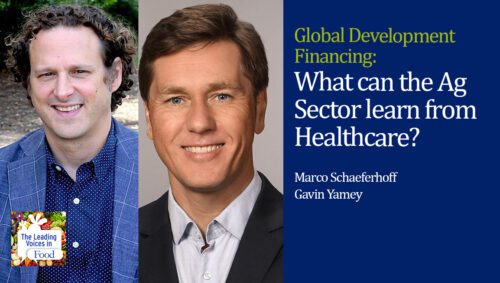Published: February 2021
Authors: Sarah Zoubek, Kelly Brownell, Gavin Yamey, Marco Schaferhoff, Ipchita Bharali, Kaci Kennedy McDade, Sebastian Martinez, Adolfo Brizzi
Key Messages
Overall financing landscape and architecture
- SDG2 needs a coordinated global financing strategy and commitments for increased public and private investment in agricultural development.
- Agricultural development funders should differentiate between the use of grants and loans more strategically, and use grant funding for: 1) de-risking private sector investment by providing first loss funds, for example; 2) directly funding non-state actors such as producer organizations; 3) soft investments governments would not use loans for, such as technical assistance, capacity building, farmer trainings, greater beneficiary consultation and evaluation services; 4) global public goods such as agriculture research, better data systems and better policy frameworks/investment guidance, etc.; and 5) flexible emergency response.
- We need further investment in global public goods such as agricultural research, better data systems, better policy frameworks/investment guidance, and piloting of new technologies.
- Progress towards SDG2 is hampered by a lack of common metrics for evaluating progress that can provide actionable context for individual country efforts within the global food system.
- Reduce the number of smaller aid activities by donor governments that are often more geostrategic than truly recipient country-driven. Pool agriculture ODA further into multilateral channels will align more coordinated financing strategies.
- Innovative financing mechanisms—such as loan buydowns and social impact bonds, targeted taxation such as the “airline solidarity levy”, and incentive-based approaches such as advance market commitments (AMCs) —have the potential to raise more funds from non-traditional sources for agricultural development.
- International aid funding should incentivize recipient countries to spend more on agricultural development.
- GAFSP’s reform to directly support producer organizations can provide a much-needed flexible source of funds. But the reform must ensure grant funds are used more strategically, including channeling more funds through non-state actors.
- With its new AA+ rating, IFAD now has an opportunity to access market funds and expand its resource base to support the most vulnerable agricultural producers. However, IFAD must be cautious of stretching already thin capacity to achieve its goals.
- IDA and ADF should utilize their connections, relationships, and country presence to take a stronger leadership role in encouraging further investment in agriculture. ADF will need to deepen their capacity to do this effectively.
Stagnating progress on SDG2 requires drastic action as business-as-usual has not generated enough change to address the scale of the problem. ODA severely falls short of the need in indebted countries, and the COVID-19 pandemic could push this goal even further out of reach as donor countries reallocate aid to emergency needs. Political will must be generated to keep ODA levels for agriculture consistent, or to increase them. But these funds can also be used more strategically, especially for leveraging additional private sector funds.
The multilateral funding mechanisms discussed in this report have a particular role to play here and any system reform must start within their own walls. GAFSP, IFAD, and ADF each require some improvements, and the World Bank should consider further leadership in the agriculture sector. For these and other actors in the system, this should include engaging in a deliberate process to distinguish their unique value add from one another, better cooperation, more co-financing, and resisting the temptation to take on new activities better suited to another entity.
Donor incoherence and inconsistent support remains central to the fragmentation in the global agricultural development sector. Reducing the number of smaller aid activities by bilaterals (that are often more geostrategic than truly recipient country-driven) and pooling agriculture ODA further into multilateral channels will align more coherent financing strategies. A larger grant-based mechanism that focuses on creatively leveraging the unique qualities of grants over loans must be a part of the future for agricultural ODA to effectively serve indebted countries. Grants must be used in the ways they are uniquely advantageous. Most critically, we must do something radically different. This includes engaging new and creative partnerships with the private sector, POs, and CSOs to see a further influx of investment, and to ensure projects have deeper, more transformational impact.
The recommendations of this report require further discussion by an inclusive group of bilateral funders, multilateral actors, recipient country representatives, and civil society. Ideally the agricultural development sector will establish a global financing roadmap for agriculture to boost global coordination, action, and investments. A series of events will be needed for such an activity and should be initiated as soon as possible.


